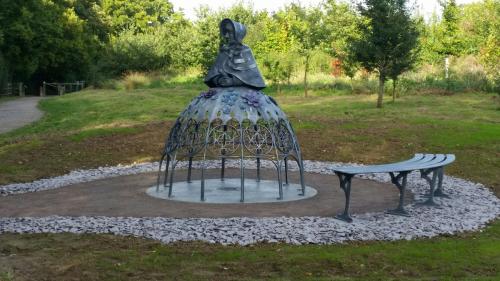Emily Temple by Helena Roden
A tribute to Emily Temple, Burgess Hill Benefactress (lived 1811-1874), sculpture situated on Malthouse Lane Meadow near Burgess Hill Burial Ground
Emily Temple was a 19th century artist, businesswoman and philanthropist. Her generosity to Burgess Hill can still be seen today through her gift of St John’s Park and some of our most attractive public buildings.
She started her working life as a modeller of wax flowers, a very popular art form at the time, often preserved under a glass dome on the mantelpiece. Wax modelling was a well-respected medium used for scientific as well as decorative purposes, for instance in the teaching of anatomy or in museum displays. Emily Temple’s creations were of sufficiently high quality to feature in the Great Exhibition of 1851.
Artist’s statement
Helena Roden Emily Temple appealed to me personally as a subject for sculpture as I also use flowers as inspiration, even if my own are 6 meters high and made from painted steel. Her interests in hand made objects, parks, education, public buildings and the common good also align with my own values. Unfortunately I have not been able to copy her example and amass the fortune that she did! A popular person, known for her kindness and charity she has nevertheless sunk into obscurity like so many women in history. I am proud to have been able to make a proper memorial to someone who did so much with her life and had the vision to create buildings and places many years ago that are still enjoyed by the people of Burgess Hill today.
When I learnt that only 2% of public sculpture (once you take out royalty) commemorates women, I was determined to design an artwork that represented the woman herself and her achievements. I have based her shape upon the costume of 1860 with its dome shaped crinoline. The round motifs on her skirt are taken from the rose window of the church of St John the Evangelist and the flowers are camellia, passionflower and forget me not, all popular subjects for Victorian wax modellers and a reference to her early career. The tickets relate to her business life. I didn’t want her to come across as a flower girl or a florist so I spent a lot of time calculating what an expensive ornament might cost in 1860, between 2 pence and 6 pence would be around the right amount. This would have been written as 2d or 6d but many people now do not know that the d would mean pence so I left the tickets as numbers.
Helena Roden
Helena Roden is an artist working in sculpture for a wide variety of public spaces. She devises and runs community engagement activities in conjunction with these commissions. Her work is inspired by the natural world and local history and by how plants and the city interact. Helena’s clients range from local authorities and housing associations to arts organisations including the British Museum. Her original training was in theatre design, aiding her understanding of the importance of the audience in art. Her giant metal flower sculptures are now a taxi drivers’ landmark. www.helenaroden.co.uk

